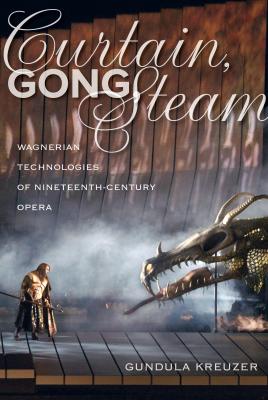Curtain, Gong, Steam. Gundula Kreuzer
Читать онлайн.| Название | Curtain, Gong, Steam |
|---|---|
| Автор произведения | Gundula Kreuzer |
| Жанр | Музыка, балет |
| Серия | |
| Издательство | Музыка, балет |
| Год выпуска | 0 |
| isbn | 9780520966550 |
Curtain, Gong, Steam
The publisher gratefully acknowledges the generous support of the Dragan Plamenac Endowment of the American Musicological Society, funded in part by the National Endowment for the Humanities and the Andrew W. Mellon Foundation.
The publisher and the University of California Press Foundation also gratefully acknowledge the generous support of the Constance and William Withey Endowment Fund in History and Music.
Curtain, Gong, Steam
Wagnerian Technologies of Nineteenth-Century Opera
_____
Gundula Kreuzer
UNIVERSITY OF CALIFORNIA PRESS
University of California Press, one of the most distinguished university presses in the United States, enriches lives around the world by advancing scholarship in the humanities, social sciences, and natural sciences. Its activities are supported by the UC Press Foundation and by philanthropic contributions from individuals and institutions. For more information, visit www.ucpress.edu.
University of California Press
Oakland, California
© 2018 by The Regents of the University of California
Library of Congress Cataloging-in-Publication Data
Names: Kreuzer, Gundula Katharina, 1975– author.
Title: Curtain, gong, steam : Wagnerian technologies of nineteenth-century opera / Gundula Kreuzer.
Description: Oakland, California : University of California Press, [2018] | Includes bibliographical references and index. |
Identifiers: LCCN 2017052549 (print) | LCCN 2017056145 (ebook) | ISBN 9780520966550 (ebook) | ISBN 9780520279681 (cloth : alk. paper)
Subjects: LCSH: Wagner, Richard, 1813-1883—Aesthetics. | Opera and technology—History—19th century. | Opera—Production and direction—History—19th century. | Opera—Stage-setting and scenery—History—19th century. | Opera and technology—History—20th century. | Opera—Production and direction—History—20th century. | Opera—Stage-setting and scenery—History—20th century.
Classification: LCC ML1700 (ebook) | LCC ML1700+ (print) | DDC 792.509/034—dc23
LC record available at https://lccn.loc.gov/2017052549
Manufactured in the United States of America / Printed in China
26 25 24 23 22 21 20 19 18
10 9 8 7 6 5 4 3 2 1
To Barbara Kreuzer
and the wise love she represents
Contents
Introduction: Opera, Staging, Technologies
2. Curtain
3. Gong
4. Steam
Epilogue: Wagnerian Failure
Notes
Works Cited
Index
Illustrations
1.1. “ ‘Atlas’ in Music,” in Puck. Humoristisch-Satyrische Wochenschrift (1877)
2.1. The Wagner curtain: draft of its mechanical construction by Walter Huneke
2.2. The Wagner curtain in 1897, framing the Bayreuth stage for Parsifal’s Grail temple in Wagner’s premiere production of 1882
3.1. Gong strikes at the beginning of Domenico Corri’s “dramatic opera” The Travellers, or Music’s Fascination (London, Theatre Royal, Drury Lane, 1806)
3.2. Tam-tam used in Paris for François-Joseph Gossec’s Marche lugubre (1790) as part of the funeral cortège for Mirabeau on April 4, 1791
3.3. Use of a gong to induce catalepsy in Jean-Martin Charcot’s neurological clinic at the Salpêtrière Hospital, Paris, during the 1870s and 1880s, as rendered in Paul Regnard’s Sorcellerie, magnétisme, morphinisme, délire des grandeurs (1887)
4.1. Interleaved stage manager’s score for productions of Das Rheingold at the Munich Court Theater showing Wotan’s descent into Nibelheim via sulfurous fumes
4.2. Bayreuth’s steaming dragon, as re-created for Angelo Neumann’s 1881 production of the Ring cycle in Berlin’s Victoria-Theater
4.3. A later satirical view of Siegfried’s dragon, likely referring to Angelo Neumann’s production as presented in London in 1882
4.4. “Steam Concert,” in [Jean-Jacques] Grandville, Un autre monde (1844)
4.5. “Steam Orchestra for Handling Wagner’s Scores,” in Kikeriki (1876)
4.6. Karl Klič, “The Bayreuth Music Steam Engine,” in Humoristische Blätter (1876)
4.7. Theo Raven’s production score for Das Rheingold documenting the 1914 Bayreuth staging and how it differed from earlier productions
4.8. The steaming hydroelectric dam in Patrice Chéreau’s centennial production of Das Rheingold, scene 1 (Bayreuth, 1976)
4.9. Mime’s industrial (and proto-steampunk) smithy in Patrice Chéreau’s 1976 Bayreuth production of Siegfried, act 1
4.10. Vera Nemirova’s cosmically misty unit set for the Ring (Opernhaus Frankfurt, 2010–12)
4.11. “Steam Swan,” in Berliner Wespen (1882)
E.1. Robot Myon arrives in front of a red velvet curtain in the Gob Squad production of My Square Lady (Komische Oper Berlin, 2015)
E.2. The “machine” in operation: models of Carl Fillion’s unit set for the Ring in Robert Lepage’s
